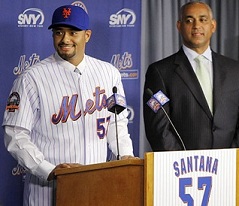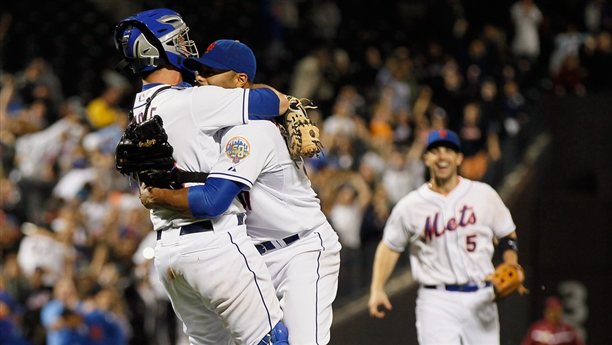January 30, 2008 was supposed to be a great day for Mets’ fans everywhere. The Mets had just acquired Johan Santana, the clear-cut best pitcher in the game, from the Minnesota Twins for pitching prospects: Philip Humber, Deolis Guerra, and Kevin Mulvey, as well as center fielder Carlos Gomez, pending an extension agreement. Even David Wright was ecstatic when he said, “If it’s true, obviously, you’re getting arguably the best pitcher in the game.”
The Mets had two days to seal-the-deal with an extension agreement, and both sides had no problem making the fans sweat it out. As the two-day window was closing both clubs asked for, and received, an MLB approved 2-hour extension beyond the Friday 5 p.m. deadline. The result was an agreement on a 6-year $137.5 Million contract extension that would make Santana a Met through 2014, should they choose to pick up his club option. The deal made Santana the highest paid pitcher in baseball history and made the Mets the new favorites to win the NL East, after a historic and forgettable collapse in 2007.
I still remember driving home from school in Plattsburgh, New York. I had a four-hour drive, and as I was driving through the Catskill Mountains, I kept losing radio reception and cell phone service. As I reached the Lake George area, I regained my radio reception and quickly tuned to ESPN. Moments later, I literally screamed aloud to myself with excitement as I fumbled for my phone to call my brother and my father to tell them that the Mets had just completed the deal for Santana.
The Mets traded four players who weren’t considered top prospects at the time. Carlos Gomez and Philip Humber have had some success at the Major League level, but neither player has developed into a star. The Yankees and Red Sox were also in on Santana at the time, but were reluctant to meet the Twins demands. As a result, Minnesota was left with nothing better on the table then to accept the Mets offer.
The record and ERA looked great on the surface, but there was more to Santana’s story than just those numbers. In the four seasons with the Twins prior to the trade, Johan had pitched at least 219 innings, while striking out a minimum 235 hitters in his dominance of the AL Central. The Venezuelan native was durable averaging 33.5 starts, while winning 70 games on his way to two Cy Young Awards. The lefty had a fastball that sat in the 91-95 Mph range, a hard slider, and a devastating change-up that just fell off the table.
The Mets had gotten a steal, or so they thought.
Things began to change with Santana once he joined the Mets. The lefty made over 30 starts and pitched over 200 innings just once, which is the same number of times he’s struck out over 150 batters. Starting as early as the 2009 season, his velocity began to dip. The mighty Santana saw the Yankees smack him around for nine earned runs in 2009, and the Phillies put up a 10 spot off him in 2010. Recently, he still showed flashes of the old Johan, but found himself struggling to muster up a heater that hit 90 on the radar gun. The drop in velocity made it easy to distinguish between his fastball and patented change. His win total fell and the injuries began to pile up. The man, who once prided himself on making only one trip to disabled list in his time with the Twins, was hurt each season with the Mets, including missing all of the 2011 season, and now likely all of 2013.
Putting the injuries aside, Santana gave Mets fans a reason to hope again when he was healthy and on the mound, plus he gave the franchise some great moments to remember forever. He pitched a complete game three-hit shutout on one leg against the Marlins, in the second to last game of the 2008 season on three days rest. He twirled the Mets first no-hitter in franchise history. The 34-year-old will be remembered as a gamer and a leader. Johan Santana was a true “ace”, but injuries derailed what could have been a Hall of Fame career.
Ultimately, the deal was the right one for the Mets at the time. However, looking at it now, you wonder how different things could have been had the trade never been made. This is a disappointing end to his Mets career, one that once had so much promise.
















